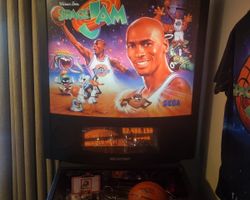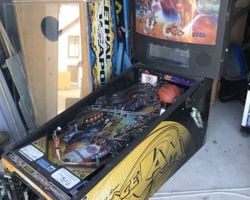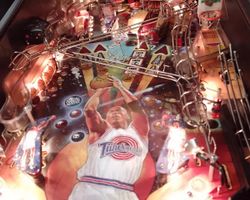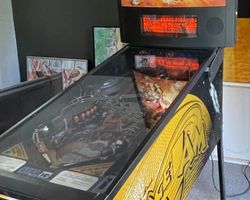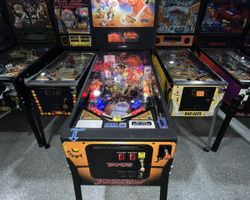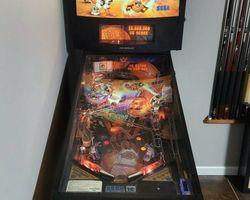Space Jam
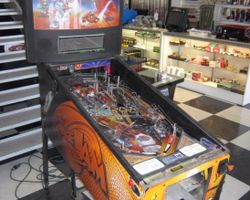
Average Prices: USD $700 to $2,200
Produced: December, 1996
Machine Type: Solid State Electronic
MPU: Sega/Stern Whitestar
Players: 4
Design by: Joe Kaminkow, Orin Day, Lonnie D. Ropp, Joe Balcer
Art by: Morgan Weistling, Jeff Busch, Marc Raneses
Music by: Brian Schmidt
Sound by: Brian Schmidt
Software by: Orin Day, Lonnie D. Ropp
The pinball machine "Space Jam," released in December 1996 by Sega Pinball, Inc., emerged from a period of significant change in the industry. Its creation was directly tied to the highly anticipated live-action/animated film of the same name, starring basketball player Michael Jordan alongside the Looney Tunes characters. This licensed theme was a strategic choice for Sega Pinball, aiming to capitalize on the movie's widespread appeal and bring a fresh, family-friendly experience to the arcade floor.
The development of "Space Jam" involved a collaborative team of designers and artists. The game's design was a joint effort by Joe Kaminkow, Lonnie D. Ropp, and Orin Day. The distinct visual identity was shaped by multiple talents: Morgan Weistling created the vibrant backglass artwork, while Jeff Busch was responsible for the detailed playfield design. Marc Raneses contributed the cabinet art and assisted with playfield production elements, creating a cohesive visual package that echoed the film's aesthetic. The engaging sound design and custom speech, featuring character voices from the movie, were crafted by Brian Schmidt, enhancing player immersion. Software development was handled by Lonnie D. Ropp and Orin Day, while Joe Balcer oversaw the mechanical aspects of the machine. "Space Jam" was part of the Sega/Stern Whitestar generation of pinball machines, a solid-state electronic platform that allowed for advanced dot matrix display (DMD) animations and sophisticated gameplay mechanics for its time. With a production run of 800 units, it was a relatively limited release, contributing to its distinct presence in the pinball landscape of the late 1990s. An interesting detail lies in the potential reuse of some DMD artwork from "Space Jam" in a later basketball-themed pinball machine, showcasing an evolutionary link between Sega's output and subsequent designs.
Signature Features and Design
"Space Jam" is defined by a series of standout features that directly translate the film's basketball theme into interactive pinball elements. A central mechanic is the "Jump Ball" feature, centered around a basketball hoop on the playfield. This assembly often incorporates magnets to capture or manipulate the ball, simulating a basket shot. The game features three distinct ramps that provide fluid shots and contribute to the machine's overall flow, a key aspect for players seeking satisfying shot trajectories. Two flippers control the ball, common for a standard pinball machine, while three bumpers add chaotic action and scoring opportunities. A single captive ball provides a target for specific modes, and three drop targets offer additional challenges and build-up to scoring phases.
The integration of two magnets into the playfield design, particularly for the "Jump Ball" shot, adds a dynamic layer to gameplay, altering ball physics and demanding precision. The custom speech, pulling directly from the movie's characters, along with lively dot matrix display animations, works in concert to immerse the player in the "Space Jam" universe. These animations depict familiar scenes and characters, reinforcing the theme and providing visual feedback for game progression. The vibrant artwork across the playfield and backglass, rich with Looney Tunes characters engaged in basketball action, ensures a visually appealing experience that directly connects players to the film's narrative. Each of these components—from the innovative basket shot to the thematic audio-visuals—enhances the gameplay experience, making "Space Jam" immediately recognizable and engaging for players of all skill levels.
Playfield and Mechanics
The "Space Jam" playfield is designed with a clear emphasis on engaging shots and accessible flow, making it inviting for a broad audience. The layout incorporates three main ramps, which are primary targets for continuous play and score accumulation. These ramps offer smooth returns, often feeding the ball directly back to the flippers for subsequent shots, promoting a sense of rhythm and flow. At the heart of the playfield is the basketball hoop mechanism, a prominent feature that serves as a focal point for gameplay and the game's central objective. Shots into this "Jump Ball" basket are often enhanced by magnets, which can catch, hold, or propel the ball, creating dynamic and satisfying scoring sequences.
Beyond the ramps and the basket, the playfield features three pop bumpers, positioned to create lively, unpredictable ball movement in the upper playfield area, adding a layer of controlled chaos. Three drop targets are strategically placed, requiring precise shots to clear and activate various game features or score multipliers. A single captive ball provides a distinct target for bonus points or mode progression. The artwork on the playfield, executed primarily by Jeff Busch, is a vibrant tapestry of Looney Tunes characters, basketball elements, and cinematic motifs from the "Space Jam" movie. Bugs Bunny, Daffy Duck, and other characters are depicted in dynamic poses, integrated seamlessly into the playfield elements, guiding the player's eye towards key shots. The lighting throughout the playfield is utilized to highlight active shots, indicate mode progression, and enhance the overall aesthetic, immersing the player in the colorful, energetic world of the film. The design philosophy behind this layout promotes a balanced experience of speed and control, offering clear objectives while maintaining a dynamic playfield that remains visually appealing.
Gameplay Dynamics
The gameplay dynamics of "Space Jam" are built around a straightforward progression system that centers on activating and completing various objectives, primarily leading to multiball modes. The core strategy revolves around hitting the three ramps and, most significantly, repeatedly making the "Jump Ball" shot into the basketball hoop. This shot is often tied to advancing through movie-themed modes or building up for significant scoring opportunities. The game features a five-ball multiball, a chaotic and high-scoring event initiated by completing specific shots or sequences. During multiball, the goal is typically to keep as many balls in play as possible while aiming for high-value targets, particularly the basket.
Unique modes in "Space Jam" are often represented by distinct DMD animations and audio cues, guiding the player through movie-centric challenges. For instance, players might need to "train" the Looney Tunes characters by hitting specific shots or engage in a "final game" where the primary objective is to make continuous basket shots. While the ruleset is designed to be accessible, it offers enough variation to keep casual players engaged. Player strategies often involve prioritizing the "Jump Ball" shot early to build momentum, then focusing on the ramps to keep the ball in play and maximize multipliers. During multiball, the focus shifts to maximizing shot repetition into the basket to accrue points rapidly. The custom callouts and musical cues, integrated seamlessly into the gameplay, reinforce the theme, providing memorable auditory feedback for successful shots and mode progression. This combination of accessible rules, clear objectives, and engaging thematic integration makes "Space Jam" a game that encourages repeat plays, particularly for those drawn to its movie tie-in.
Reception and Legacy
The "Space Jam" pinball machine garnered a generally positive reception, particularly among those who valued its theme and accessibility. Many players found it to be an enjoyable and fun machine, especially for families and individuals new to pinball. Its successful integration of the movie's theme, featuring the Looney Tunes characters and basketball elements, was widely praised. The artwork, notably the backglass by Morgan Weistling and the playfield by Jeff Busch, consistently received positive comments for its vibrant portrayal of the film's universe. The custom character voices and callouts, crafted by Brian Schmidt, were also well-regarded, adding an authentic layer of immersion.
Players often highlighted the game's satisfying layout, which offered enjoyable shots, including the three ramps and the distinctive "Jump Ball" feature. The use of magnets, particularly in the basket shot, was frequently cited as a creative and engaging mechanical highlight. The game's flow, balancing speed with control, contributed to a pleasing playing experience. For fans of the "Space Jam" film, the machine offered a strong sense of nostalgia, effectively translating the movie's energy into pinball form. Its straightforward rules and clear objectives made it highly approachable for beginners and casual players, positioning it as an excellent choice for a wide audience.
However, "Space Jam" was not without its criticisms, primarily from experienced pinball enthusiasts seeking greater depth. The most common feedback pointed to a perceived lack of complex rules and a degree of gameplay repetition. Some players found the game too easy or not challenging enough for extended engagement, suggesting that the ruleset could feel shallow compared to more intricate designs. While the "Jump Ball" shot was a strength, some felt the game became overly focused on it and the multiball mode, leading to a sense of predictability. Certain aesthetic aspects also drew minor critique, such as some of the cabinet art, and a few reports of scratchy audio or mispronounced words in the callouts surfaced. Reliability issues, such as occasional ball jams or problems with the basket mechanism, were mentioned by a small number of owners, though these were not widespread systemic issues. Concerns about plastic durability on certain high-impact shots were also noted.
Despite these points, the overall sentiment toward "Space Jam" remains positive. It holds a reputation as a highly accessible and entertaining game, particularly for those who appreciate its thematic integration and family-friendly nature. While it may not occupy the upper echelon of machines for competitive players, its status as a fun, approachable, and thematically cohesive pinball experience endures. "Space Jam" stands as a notable example of a successful licensed theme from the mid-1990s, showcasing Sega Pinball's ability to translate popular culture into an engaging mechanical format, appealing to a broad demographic and contributing to the diverse tapestry of the Whitestar generation.
Sponsored Links
 Ebay Listings
Ebay Listings
 Auction Results
Auction Results
| Cost | Location | Date |
|---|---|---|
| AUD $3,300 |  Victoria, Australia Victoria, Australia |
16 September, 2024 |
| USD $7,499 |  California, United States California, United States |
04 September, 2024 |
| GBP £1,700 |  Glasgow, United Kingdom Glasgow, United Kingdom |
04 August, 2024 |
| GBP £1,949 |  North Walsham, United Kingdom North Walsham, United Kingdom |
05 April, 2024 |
| AUD $3,790 |  Victoria, Australia Victoria, Australia |
24 January, 2024 |
| USD $5,300 |  California, United States California, United States |
25 March, 2023 |
| USD $3,675 |  Arkansas, United States Arkansas, United States |
11 April, 2022 |
| USD $6,999 |  California, United States California, United States |
12 March, 2022 |
| USD $3,400 |  New Jersey, United States New Jersey, United States |
22 February, 2022 |
| USD $4,599 |  Florida, United States Florida, United States |
30 November, 2021 |


Private Policy · Search Website · Contact Us
As an eBay Partner, we may earn a commission from qualifying purchases made through links on this site, at no additional cost to you.
All trademarks and copyrighted materials remain property of their respective owners. All other content copyright 2007 - 2026 Pinpedia.

